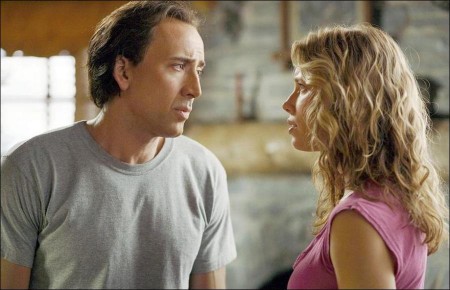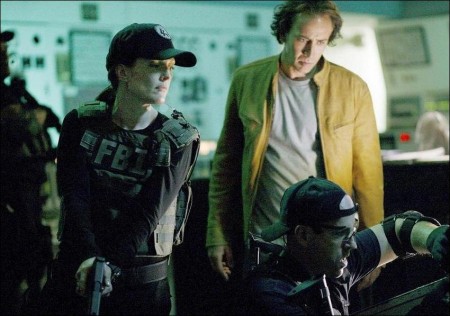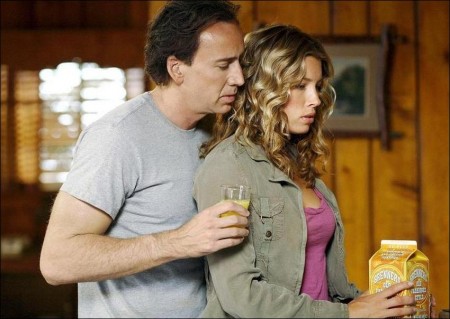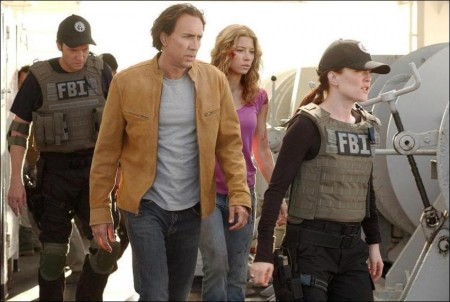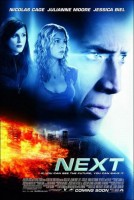Tagline: If you can see the future, you can save it.
In Revolution Studios’ exciting sci-fi thriller “Next,” Academy Award winner Nicolas Cage stars as Cris Johnson, a Las Vegas magician with a secret gift that is both a blessing and a curse: He has the uncanny ability to tell you what will happen next.
Johnson can see a few minutes into the future, an extrasensory talent that comes in handy for his job as a magician and mentalist in a seedy Vegas club where he performs nightly. It also has its uses at the blackjack tables when Cris needs some extra cash.
But his talent is no mere parlor trick, and his dexterity with the portals of time has not gone totally unnoticed. Vegas security guards are watching through their all-seeing casino floor cameras, eager to decipher his knack for consistently beating the odds. And FBI counter-terror agent Callie Ferris, played by Oscar nominee Julianne Moore, is eager to tap his brain to help thwart a terrorist group’s planned attack on Los Angeles with a weapon of mass destruction.
With the nuclear time bomb ticking, Cris Johnson could be key in averting a nuclear holocaust. If he doesn’t use his powers to back-channel through the right portals and change the present, his future – and the future of hundreds of thousands- could be a thing of the past.
The Futuristic Vision of Sci-Fi in the Present: The Making of “Next”
In today’s sometimes justifiably paranoid world, where once sacrosanct edifices have been destroyed by terrorists, it’s not too much of a stretch to imagine that out there, others are plotting yet another similarly unspeakable act.
To avert this frightening possibility, it would be most valuable if we could see into the future, and that’s exactly the premise that attracted screenwriter Gary Goldman to Philip K. Dick’s short story, The Golden Man, a sci-fi tale which he decided to update and reset in the present day. “What I liked most about the story was that the protagonist Cris Johnson is a `pre-cog.’ Yes, he can see two minutes into his own future, which gives him a vast amount of power, but that gift also has its limitations,” says Goldman.
The idea of turning “Next” into a motion picture stemmed from the release of the hit Steven Spielberg film “Minority Report” in 2002, which was also adapted from a work by Dick and on which Goldman was the screenwriter and executive producer.
“I was approached by Jason Koornick, who created and ran the official Philip K. Dick website, who said he wanted to interview me,” explains Goldman. During the course of the interview, Koornick told Goldman that he had negotiated a compensation package with the Philip K. Dick estate in return for running the website. It included an option on one of the author’s short stories of his choosing. The two men decided to form a partnership since Goldman already knew how expensive and difficult it is to secure an option a Dick story, and Koornick was well aware of the challenges of adapting and producing one. Together they set their sights on Dick’s story The Golden Man.
Although the original short story takes place in the future, Goldman decided to set the story in the present. Koornick refers to this as genre speculative fiction because, he explains, “science fiction takes place in the future, with future technology and aliens. `Next’ is set in the real world that we all recognize. It obeys all the laws of physics except in the case of the central character,” explains Koornick.
What Goldman liked best about the protagonist’s precognitive ability was that it approached life in the same way that many of us learn how to play video games. “When you play a video game, you try something out. You see if it works and then, eventually, you get killed. After that, you do it over and you get better at it. You’re able to understand and learn things from your previous mistakes and bring them to bear during your next attempt. The idea of being able to live life as if you were playing a video game, I think, is very appealing, and that’s basically what Cris is able to do. With his gift, he is able to live his life up to the point where he’s harmed or killed. “And then he’s able to snap back and play it again and again, each time going a little further until he gets it right.”
The unique nature of how this gift is manifested, however, is what really fascinated Goldman. “Golden Man has a character with a super power, which is precognition, the ability to see into the future, but it’s done in a way that we’ve never really seen before,” he adds. “Instead of just being a clairvoyant who can glimpse something far into the future, Cris has a kind of future radar. He can see with absolute precision a short distance into his own (and only his own) future. I was very excited about the possibility of putting this on screen.”
Goldman and Koornick brought the idea to producer Norm Golightly, head of production for Nicolas Cage’s Saturn Films. “It was instantly something we wanted to do,” says Golightly. “We asked Gary if he would write the script and then come back to us, which he did. And Nic reacted to it about as strongly as I’ve ever seen him react to any first draft.”
Cage was attracted to the story for several reasons, he says. “I admire Philip K. Dick; he’s edgy and uncompromising, and his unique voice in writing translates successfully to films.”
He also enjoys being challenged by every new role and “Next” seemed like a new frontier for him. “I was interested in a man who appears to be average and normal, but who was born with a gift of being able to see two minutes into his own future. I’d never played a character like that before. This also was a different genre for me because it’s not science fiction. It’s paranormal. So there are no electronic gizmos or futuristic backdrops. And Cris’ `precogging’ and the unique way he thinks is a marvelous playing field for an actor.”
When he received Goldman’s script, Cage says he was immediately hooked. “I read it and thought it was a very original and heartfelt adventure film. I had never seen anything like it. So I thought, let’s go get this made.”
Cage and Golightly brought the script to Revolution Studios’ production executive/producer Todd Garner, who took to the project for several reasons. “I liked the fact that at its heart, `Next’ is a beautiful love story.” It also helped that he was a huge Cage fan and had previously worked with him on such films as “Con Air” and “Gone in 60 Seconds.” “Nic is not only a great action hero, he is an unbelievably sympathetic actor. His acting doesn’t require dialog, which is what makes him so exceptional. You can read a sentiment on his face. He can convey so much without saying a word.”
Producer Koornick agrees, adding “The reason that Nic is ideal for this role, besides the fact that he’s a great actor, is that he has an intensity in his facial expressions that makes it very interesting for a viewer to imagine what he’s thinking at any given time. He can convey this wide range of emotions even when he’s not speaking. He’s in his own world and envisioning these events playing out. To be able to convey that in real time as we’re watching him while he’s thinking forward, adds so much to how the story is going to play.”
Bringing director Lee Tamahori on board was…next. “I’ve been a Lee Tamahori fan for some time,” says Cage. “I watch his film `The Edge,’ with Anthony Hopkins and Alec Baldwin, annually. I feel connected to that movie. I also like `Once Were Warriors.’ I can see Lee’s association with his actors; he has a real facility for getting the best performances out of them.”
Producer Garner agrees. “Although we knew Lee had the action movie genre down with its exciting visuals and stunts, as he showed in his James Bond film `Die Another Day’ and `XXX: State of the Union,’ we were also attracted by his earlier works in which he dealt with stories that were on a more human level.”
“I wanted Lee to dig deep into the development of the characters and try to think out every aspect of what Chris’ unique ability would be like for him,” says Cage. “And he was up for that. In a lot of scenes, he helped me find the right levels of anger and frustration.
Casting Julianne Moore as Agent Callie Ferris was an easy choice for the filmmakers. “Julianne is someone I’ve always admired because she’s always doing something different,” says Cage.
Although Moore had previously played FBI Agent Clarice Starling in “Hannibal,” the actress had a different focus for Ferris. “Here I’m finally playing the antagonist. It’s fun because I don’t have to worry about being sympathetic,” she laughs. “Ferris is working at cross-purposes with Cris. She tries to make him realize that he should cooperate with the government to help quash the terrorist threat of a nuclear bomb going off somewhere in Los Angeles; that the needs of many are more important than the needs of the one, himself.”
In terms of the needs of the one, Cris resists at first because he doesn’t want to be held captive in some underground government facility, watching television or reading graphs for the rest of his life. He sees his future with a beautiful, uncomplicated woman. But after he meets her, both their lives become much more complicated. The romance has another ripple effect. When he begins to fall in love with this woman, he suddenly gains the ability to see much farther into the future – which makes his cooperation with the FBI agents even more crucial.
The filmmakers chose Jessica Biel to play the love of Chris’ life, Liz Cooper, a teacher trying to make a difference by teaching underprivileged children. The actress jumped at the chance to be in “Next” for several reasons: “Acting in a film with such exceptional talent and experience as director Lee Tamahori, and actors like Nic Cage and Julianne Moore was amazing to me,” says Biel. “Lee brought a very relaxed tone to the set. And he was completely open to improvisation, so I felt free to experiment with my role,” she continues.
“Julianne has made such smart and diverse choices in her career. I was just so eager to watch her and figure out how she acts so brilliantly and effortlessly. And Nic is so thorough about his performances and who his characters are and how they behave that it spurred me on to kick up my performance. He made me go a little bit deeper, to try and find other layers in my character. He set a high bar that I wanted to meet,” says Biel.
Cage, for his part, honed in on Biel’s special talents throughout the script development process. “We set out to find ways to make both mine and Jessica’s characters have a very romantic quality. Jessica plays this part, she’s very beautiful and has a quality that makes you feel you could be friends with her, whereas Cris is kind of unusual and his mannerisms are different and he doesn’t seem like everybody else. So it’s an interesting match that these two would fall in love.”
Biel describes her character as a “kind of the damsel in distress throughout the film, which was a real switch for me.” The actress is best known for her action roles in such movies as “Blade” and “Stealth.” “It was nice to be a regular girl,” says Biel. “I didn’t have to work out or learn any special skills to play her. I play a dedicated school teacher leading a simple life, and then BAM, I’m running from the Feds, and falling for this guy who is telling me that he can see the future, and being thrown into terrifying situations.”
In effect, Biel had to un-train herself for the role. “I had to do the opposite of action. I tried not to look really cool when I ran. And I didn’t get to beat anyone up. I had to play Liz a little bit more feminine and soft, which is not what I’m used to,” she says.
Cage has also been an action hero in many films. But while his character in “Next” gets into many confrontations, he often found ways to skirt a confrontation by using his special abilities. “For Cris, it’s really all about the art of fighting without fighting,” says Cage. “Because he can see things before they happen, he can avoid a fight in a lot of ways. It’s fun, and I thought it would be interesting to watch.”
For these sequences, Cage utilized choreography and stunt training, which incorporate some modern dance – Yes, modern dance. Cage had modern dance instructor Scott Grossman on the set to show him different ways of moving in a fight. “I thought that Cris would have a distinctive approach to movement considering he could see what was coming,” says Cage. “Therefore he could duck out of the way. He was a New Age action here. Also, I felt comfortable incorporating the dance movements because my mother was a modern dancer.”
Being a lover and a fighter isn’t the only way Cage performed dual roles on “Next.” He also served a dual role as actor/producer, as he had on such previous films as “Lord of War” and “The Wicker Man.” “The job of actor and producer seems to be merging more often for me these days,” says Cage. It’s a lot more convenient for me to get ideas across if I go through the channels that our film company, Saturn Films, offers me.”
Cage contributed many significant story points for “Next.” It was his idea that Cris be a magician. “I thought it would make him more believable,” says Cage. “Because if a man was born with these precognitive powers, he would stand the chance of being ostracized, considered a freak or an alien. And he would probably scare people. So he’d want to hide that fact and the best way to do it is to hide in plain sight; to mask it within the guise of being a magician.”
The decision to make Cris a magician didn’t actually take hold until after filming had begun. “So all the actors and Lee were looking at me doing a test for this stage character `Frank Cadillac,’ and I’m sure they were thinking, `What are you doing?”’ laughs Cage. “But Lee, being the collaborative director that he is, went along with it.”
Not only did Cage think that making Cris a magician was good for the story, it was also fun for him personally. “I’ve always been interested in magic. So I got a great magic team on the set with me. Magician Sir James Brown taught me some magic and made sure it went smoothly,” says Cage. “It was a child’s dream come true for me.”
Another surprise for the production came when Cage suggested casting his wife Alice in the film just days before the filming of her scene took place. Alice Cage plays a woman whom Frank Cadillac calls up to the stage during his Vegas show. “It was Alice’s first time acting,” says Cage. “She’s not interested in being an actress. But I thought it would be fun for us to have that moment together. And it was.”
Canyons and Cliff-Hangers Shaking Up the Action on Location
Filming began on “Next” in spring at the Morongo Casino in Cabazon, California, which doubled for the generic Las Vegas casino where Cris gambles in the film. “Morongo was great to us,” says producer Garner. “They gave us a lot more freedom and access there, than if we had shot in Las Vegas.”
After two weeks of shooting there, the company moved to Big Bear and Lake Arrowhead for the exterior of the film’s Cliffhanger Motel, as well as its outdoor mountain sequences.
Veteran producer Arne L. Schmidt (who had just produced “XXX: State of the Union” with director Tamahori) says the location was chosen because “we needed a cliffside motel with a steep slope behind it because an avalanche of sorts was going to take place there. We found a great place called The Cliffhanger Restaurant that our production designer, Bill Sandell, transformed into a motel,” says Schmidt.
Although The Cliffhanger was exactly what the script called for, the unpredictable weather was not. “The location was at the end of this precipice, at 8,000 feet. So it had its own little microclimate,” explains Schmidt. “Every day would start out sunny in the morning, and then it would get blindingly foggy in the afternoon. No other place around us was foggy. This was a nightmare. It was very disruptive for production, causing us havoc trying to match shots over several days.”
A master of adaptation, Tamahori found a way to salvage the days. “Lee was very quick on his feet,” says Schmidt. “We had one day where Lee and (director of photography) David Tattersall shot close-ups. This way, you couldn’t see that much fog. Then for about 2 ½ hours, the fog lifted and Lee managed to fit 12 hours of filming into that small window. I don’t know many directors around who could have done that.”
The film’s avalanche sequence, in which Cris is running down a long steep slope, with the Feds and boulders, a water tower, a steam locomotive, logs and debris tumbling down behind him, took over a week to complete.
“It’s a good thing that Nic was in such good shape,” says Schmidt, “because we started filming on one mountain and continued on several different locations to create one sheer, continuous mountain. Nic not only had to run down these slopes, he also had to walk back up again and again, at 8,500 feet above sea level. It was a week of jumping, ducking and diving. And he did it without even breathing that hard.”
After three weeks of filming in the California mountains, the production proceeded to Long Beach at the Port of Los Angeles for the film’s biggest sequence which contains terrorists, SWAT teams, FBI agents, helicopters, gunfire and explosions aboard an enormous cargo ship.
Schmidt assembled a top-notch technical team for this Herculean task. “In order to make a film like this, you must have people who are really capable and experienced,” he observes. “Then it’s a question of organizing and breaking down scenes into what we can manage each day and making it look as realistic as possible.”
Renowned supervising stunt coordinator R.A. Rondell (a third generation stunt man) choreographed the scenes with director Tamahori using more than 35 stuntmen, background fighters, special effects people and helicopters for the attack of the cargo ship holding the explosives.
“It took me a few weeks to figure it out and bring suggestions to Lee. I gave him everything in the location that he might want, and some he hadn’t even thought of, and I let him choose. After all, it’s his playground, and he usually has great ideas; he has a great eye for camera, action, movement,” notes Rondell.
Tamahori and Rondell decided that they wanted to shoot the attack on the boat in a documentary style. With the help of special effects supervisor Clay Pinney (who had worked with Rondell on “The Matrix”) they mapped out the following scenario: “The terrorists come aboard. They smoke bomb the area, taking no prisoners,” says Rondell. “There’s a feeling of claustrophobia, noise, effects and confinement; close-ups of people screaming, someone dying next to you, you have to take care of them and move on. We wanted it to be right in your face, not done in Hollywood broad strokes. We were more concerned with the chaos of battle, rather than the end result of a man being killed. That’s what makes it so scary.”
To make things even more realistic, Schmidt brought in Jared Chandler as the military technical advisor. “Jared is a former Special Forces guy. Plus, he understands the movie business,” says Schmidt. “Whenever there was a scene that involved tactical movement or weapons handling, he was our go-to guy. He taught the actors and extras how to carry themselves properly, dress properly, make sure their equipment was tight and right. He also helped with making sure the military dialog sounded appropriate.”
Chandler greatly facilitated the production because he knew the answers to military questions right on the spot. This and his knowledge of the logistics of filmmaking made him invaluable. “It was great to work with Jared because he gently explains how the scene is going to happen, how I should set it up, what will be the formation, how you pass a sniper rifle,” says Julianne Moore.
To add yet another layer of authenticity, the production utilized the services of Jody Hart’s Combat Casting Company, former military men, SWAT team members and policemen who are comfortable using firearms like M4s and AK47s.
“Next” also has several helicopter action sequences, for which the production brought in aerial coordinator Cliff Fleming. “Cliff is one of the best pilots in the business and the world,” says Schmidt, who had previously worked with the aviator on “Rules of Engagement” and “We Were Soldiers.” “When he’s not doing movies, NASA hires him to retrieve satellites for them.”
Moore appreciated Fleming’s presence and supervision. “We had a helicopter without any doors during the sequence when we land at the Port of Los Angeles, and I’d never been in a door-less helicopter before. It can make you feel a bit unstable. But Cliff and his crew showed me how to get Nic into the helicopter first, check his seatbelt before I did my own, and alerted me to the fact that it would take off immediately. They were so supportive with their instructions and very mindful of everyone’s safety, but they were also concerned that we looked like we knew what we were doing.”
With the sequence so meticulously planned and laid out to be technically perfect, now it was up to Tamahori and his cast to make it crackle. As producer Golightly observes, “That’s why we were so excited about Lee directing this film.
He has that rare ability to work both ends of the spectrum, from large action films to small, intimate character-driven pieces. `Once Were Warriors’ is one of my favorite films and one of Nic’s as well. He achieved great character work and plotting on that film, and great action skills in the Bond film, for example. So naturally, we thought if both those Lee Tamahoris exist it would be fantastic if we could harness them and put it all into one film with incredible action set pieces, amazing characters and a unique plot.”
Filming concluded at the Havasupai Indian reservation, located at the bottom of the Grand Canyon, for a scene in which Liz teaches the Native American children and exposes Cris to the natural wonders of the surroundings.
The idea to use this remote location came from the ever-romantic Cage, who had taken his wife Alice there on their first date. “We were dropped off by helicopter at the bottom of the Canyon, and we went for a hike. And I met all these wonderful Native Americans. It was the most beautiful place I’d ever seen,” he says. “And I thought, `no one’s ever seen this area, its gorgeous waterfall and fantastic rocks, and it’s right in our own backyard.’ So, I wanted to share that with the audience through this film.”
Logistically, however, it was not a backyard shoot, and Schmidt says it all had to be carefully planned. “We took a third of our normal crew, about 54 people,” says Schmidt. “A limited amount of crew stayed at a small hotel, about an hour’s drive away, and then we helicoptered them down to the location. The remaining cast and crew stayed in Las Vegas, and would helicopter in from there (a 1 ½ hour ride in choppers holding six or seven).
Aerial coordinator Cliff Fleming not only handled the people-moving, he also brought in lighting equipment, food and water. “It was 105 degrees at the bottom, so we went through plenty of water,” notes Schmidt.
Another constraint was the steep walls of the Canyon. The morning light wasn’t suitable for filming until around 10:00 a.m. and started to disappear as early as 5:00 p.m. “This really restricted our day on top of everything else,” says Schmidt. But it was worth it, he notes, because of the natural beauty and unique terrain. “No other movie has ever been shot there,” he notes. “In fact, the Havasupai people, in general, don’t like to be photographed,” says Schmidt. “But Nic had been there several times before as a tourist, and he’d bonded with them. I’m sure that’s why their tribal council gave us their permission.”
In turn, the production cast all the Havasupai who wanted to work (50-60 adults and the 11 children who played Liz’s students at the waterfall). The tribal Chieftain played a wise old shaman in a sequence in which Cris performs magic trick for the kids.
In all, the company shot two days on the canyon floor, a day and a half at the glorious waterfall nearby and a half-day in the little town on the Havasupai reservation. “When we were near the end of our time there, the Havasupai and their 11 year-old tribe princess did a special dance for us in their traditional garb.
“We all got in a circle and danced with them. It was a wonderful, spiritual experience,” says Schmidt.
By the end of production, Cage was convinced that he had realized his ambition, both as an actor and creative producer, on “Next.” “I enjoy romantic films, and adventure movies and action. The best is when you can combine them as we did on this movie,” he says. “It has unique characters. I’m hopeful `Next’ will provide as interesting an experience for audiences as it did for those of us who made it. And I believe it will.”
Production notes provided by Revolution Studios.
Next
Starring: Nicolas Cage, Julianne Moore, Jessica Biel, Peter Falk, Torrie Kittles, John Kretschman
Directed by: Lee Tamahori
Screenplay by: Gary Goldman
Release Date: April 27th, 2007
MPAA Rating: PG-13 for intense sequences of violent action, language.
Studio: Revolution Studios
Box Office Totals
Domestic: $18,211,013 (24.8%)
Foreign: $55,330,487 (75.2%)
Total: $73,541,500 (Worldwide)
